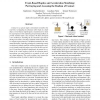Free Online Productivity Tools
i2Speak
i2Symbol
i2OCR
iTex2Img
iWeb2Print
iWeb2Shot
i2Type
iPdf2Split
iPdf2Merge
i2Bopomofo
i2Arabic
i2Style
i2Image
i2PDF
iLatex2Rtf
Sci2ools
HAPTICS
2005
IEEE
2005
IEEE
Event-Based Haptics and Acceleration Matching: Portraying and Assessing the Realism of Contact
Contact in a typical haptic environment resembles the experience of tapping on soft foam, rather than on a hard object. Event-based, high-frequency transient forces must be superimposed with traditional proportional feedback to provide realistic haptic cues at impact. We have developed a new method for matching the accelerations experienced during real contact, inverting a dynamic model of the device to compute appropriate force feedback transients. We evaluated this haptic rendering paradigm by conducting a study in which users blindly rated the realism of tapping on a variety of virtually rendered surfaces as well as on three real objects. Event-based feedback significantly increased the realism of the virtual surfaces, and the acceleration matching strategy was rated similarly to a sample of real wood on a foam substrate. This work provides a new avenue for achieving realism of contact in haptic interactions.
Haptic Rendering Paradigm | HAPTICS 2005 | Realistic Haptic Cues | Typical Haptic Environment | Virtual Reality |
| Added | 24 Jun 2010 |
| Updated | 24 Jun 2010 |
| Type | Conference |
| Year | 2005 |
| Where | HAPTICS |
| Authors | Katherine J. Kuchenbecker, Jonathan Fiene, Günter Niemeyer |
Comments (0)

